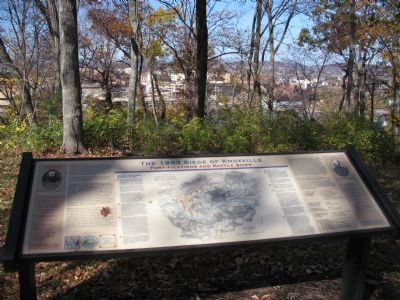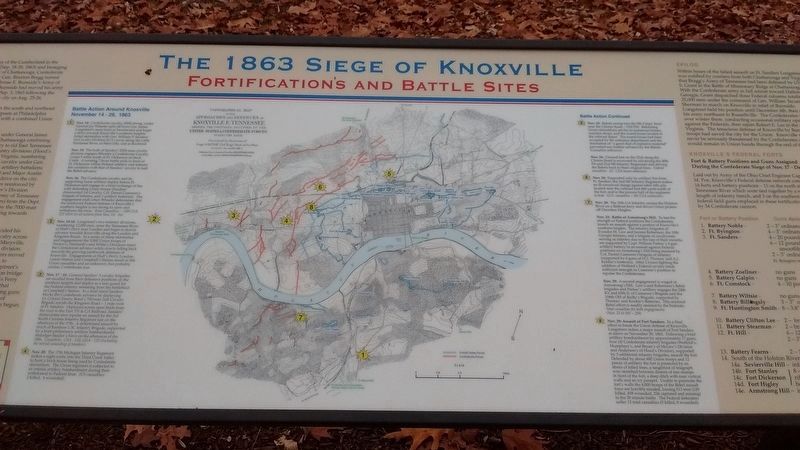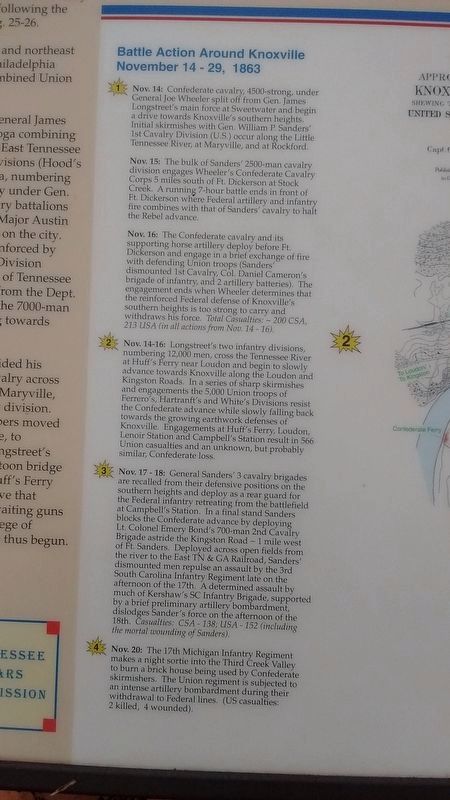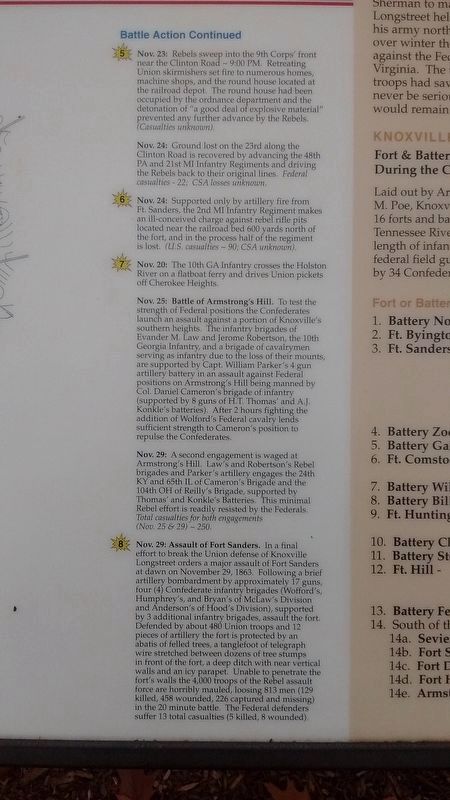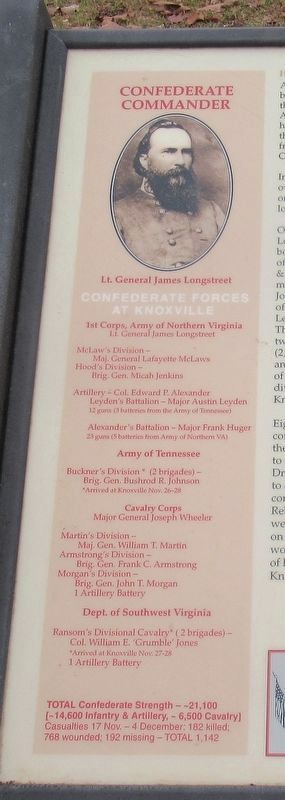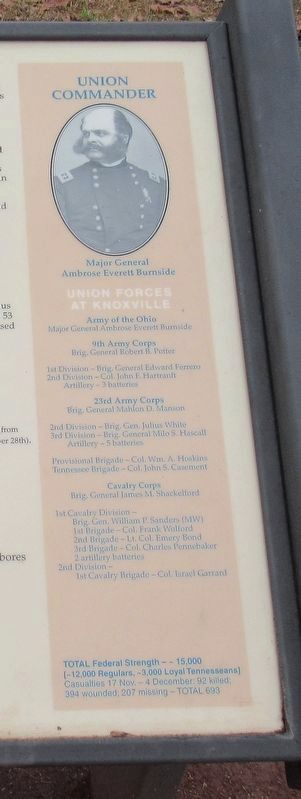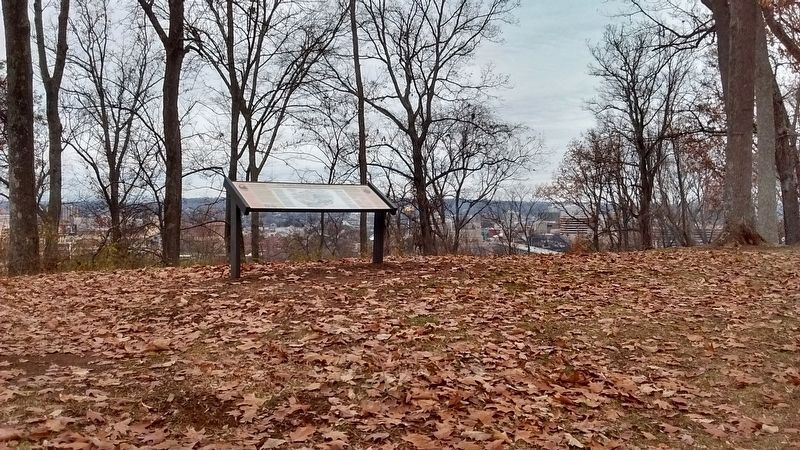Knoxville in Knox County, Tennessee — The American South (East South Central)
The 1863 Siege of Knoxville
Fortifications and Battle Sites
After defeating the Union Army of the Cumberland in the bloody battle of Chickamauga (Sep 18-20, 1863) and besieging the Federal provisions in the city of Chattanooga, Confederate Army of Tennessee Commander Gen. Braxton Bragg turned his attention to driving Gen. Ambrose F. Burnside’s Army of the Ohio out of East Tennessee. Burnside had moved his army from Kentucky into Knoxville on Sept 3, 1863 following the Confederates’ abandonment of the city on Aug. 25-26.
Initial Confederate movements from the south and northeast overwhelmed the Union cavalry outposts at Philadelphia on Oct. 22 and Rogersville on Nov. 5 with a combined Union loss of more than 1,100 men.
On November 5 a powerful command under General James Longstreet began moving north from Chattanooga combining both the power and experience necessary to rid East Tennessee of its Union occupiers. Two veteran infantry divisions (Hood’s & McLaws') from the Army of Northern Virginia, numbering more than 12,000 men, bolstered by 4,500 cavalry under Gen. Joe Wheeler (Army of Tennessee), and the artillery battalions of Col. Edward Porter Alexander (23 guns) and Major Austin Leyden (12 guns) began a slow, inexorable drive on the city. Three weeks later this force would be further reinforced by two infantry brigades from Simon B. Buckner’s Division (2,625 men under Bushrod Johnson) of the Army of Tennessee and nearly 2,000 additional cavalry (2 brigades) from the Dept. of SW Virginia. About the same time a drive by the 7000-man division of Gen. Robert L. Ransom began moving towards Knoxville from southwestern Virginia.
Eight days later, on November 13, Longstreet divided his command at Sweetwater—sending Wheeler’s cavalry across the Little Tennessee River, through Rockford to engage Gen. William E. Sanders’ Union cavalry at Maryville. Driving Sanders’ cavalry before it, Wheeler’s cavalry was ordered to attack Knoxville’s southern heights. Meanwhile, to complete the envelopment of Burnside’s army, Longstreet’s Rebel infantry and artillery force assembled a pontoon bridge west of Loudon, crossed the Tennessee River at Huff’s Ferry on the right of the 14th, and began a three-day drive that would bring it to the outskirts of Knoxville and the waiting gins of her 15,000 Union defenders. The Confederate siege of Knoxville and the battles to determine its fate were thus begun.
Epilog. Within hours of the failed assault on Ft. Sanders Longstreet was notified by couriers from both Chattanooga and Virginia that Bragg’s Army of Tennessee had been defeated by Ulysses S. Grant in the Battle of Missionary Ridge at Chattanooga. With the Confederate army in full retreat between Dalton, Georgia, Grant
dispatched three Federal columns totaling 25,000 men under the command of Gen. William Tecumseh Sherman to march on Knoxville in relief of Burnside. Longstreet held his position until December 4th, then moved his army northeast to Russellville. The Confederates would over winter there, conducting occasional military operations against the Federals, then rejoin Robert E. Lee in the spring in Virginia. The tenacious defense of Knoxville by Burnside’s troops had saved the city for the Union. Knoxville would never be seriously threatened by the Confederates again., and would remain in Union hands through the end of the war.
Knoxville's Federal Forts
Fort & Battery Positions and Guns Assigned During the Confederate Siege of Nov. 17 - Dec. 4, 1863.
Laid out by Army of the Ohio Chief Engineer Capt. Orlando M. Poe, Knoxville's Federal defense network consisted of 16 forts and battery positions — 13 on the north side of the Tennessee River which were tied together by a … length of infantry trench and 3 on the southern heights. The 55 federal field guns emplaced in these fortifications were opposed by 34 Confederate cannons.
Fort or Battery Position • Guns Assigned
1. Battery Noble — 2-3" ordnance rifles
2. Ft. Byington — 4-3" ordnance rifles
3. Ft. Sanders — 4-20 pound Parrot rifles, 6-12 pound Napoleon smoothbores, 2-3"
ordnance rifles
4. Battery Zoellner — two guns
5. Battery Galpin — no guns
6. Ft. Comstock — 4-10 pound Parrots
7. Battery Wiltsie — no guns
8. Battery Billingsly — 3-3" ordnance rifles
9. Ft. Hunington Smith — 8-?" Rifles
10. Battery Clifton Lee — 2-brass 6 pound smoothbores
11. Battery Stearman — 2-brass 6 pounders
12. Ft. Hill — 6-12 pound Napoleons, 2-3" ordnance rifles
13. Battery Fearro — 2-12 pound howitzers
14. South of the Holston River —
14a. Seviervill Hill — infantry trench only
14b. Fort Stanley — 8-3" ordnance rifles were divided betweeen these forts
14c. Fort Dickerson —
14d. Fort Higley —
14e. Armstrong Hill — infantry trench only
(map)
Battle Action Around Knoxville
November 14-29, 1863
(1) • Nov. 14: Confederate cavalry, 4500-strong, under General Joe Wheeler split off from Gen. James Longstreet's main force at Sweetwater and begin a drive towards Knoxville’s southern height. Initial skirmishes with Gen. William P. Sanders 1st Cavalry Division (U.S.) occur along the Little Tennessee River, at Maryville, and at Rockford.
Nov. 15: The bulk of Sander’s 2500-man cavalry division engages Wheeler's Confederate Cavalry Corps 5 miles south of Ft. Dickerson at Stock Creek. A running 7-hour battle
ends in front of Ft. Dickerson where Federal artillery and infantry fire combines with that of Sanders' cavalry to halt the Rebel advance.
Nov 16: The Confederate cavalry and its supporting horse artillery deploy before Ft. Dickerson and engage in a brief exchange of fire with defending Union troops (Sanders’ dismounted 1st Cavalry, Col. Daniel Cameron's brigade of infantry, and 2 artillery batteries). The engagement ends when Wheeler determines that he reinforced Federal defense of Knoxville's southern heights is too strong to carry and withdraws his force. Total Casualties: ~200 CSA, 213 USA (in all actions from Nov. 14-16).
(2) • Nov. 14-16: Longstreet's two infantry divisions numbering 12,000 men, cross the Tennessee River at Huff's Ferry near Loudon and begin to slowly advance towards Knoxville along the Loudon and Kingston Roads. In a series of sharp skirmishes and engagements the 5,000 Union troops of Ferrero's, Hartranft's and White's Divisions resist the Confederate advance while slowly falling back towards the growing earthwork defenses of Knoxville. Engagements at Huff's Ferry, Loudon, Lenoir Station and Campbell's Station result in 566 Union casualties and an unknown, but probably similar, Confederate loss.
(3) • Nov. 17-18: General Sanders' 3 cavalry brigades are recalled from their defensive positions on the southern heights and deploy as a rear guard for the Federal infantry retreating from the battlefield at Campbell's Station. In a final stand Sanders blocks the Confederate advance by deploying Lt. Colonel Emery Bond's 700-man 2nd Cavalry Brigade astride the Kingston Road ~1 mile west of Ft. Sanders. Deployed across open fields from the river to the East TN & GA Railroad, Sanders’ dismounted men repulse an assault by the 3rd South Carolina Infantry Regiment late on the afternoon of the 17th. A determined assault by much of Kershaw's SC Infantry Brigade, supported by a brief preliminary artillery bombardment dislodges Sander's force on the afternoon of the 18th. Casualties: CSA - 138, USA - 152 (including the mortal wounding of Sanders).
(4) • Nov. 20: The 17th Michigan Infantry Regiment makes a night sortie into the Third Creek Valley to burn a brick house being used by Confederate skirmishers. The Union regiment is subjected to an intense artillery bombardment during their withdrawal to Federal lines. (US casualties 2 killed, 4 wounded).
Battle Action Continued
(5) • Nov. 23: Rebels sweep into the 9th Corps’ front near the Clinton Road ~9:00 PM. Retreating Union skirmishers set fire to numerous homes, machine shops, and the round house located at the railroad depot. The round house had been occupied by the ordnance department and the detonation of "a good deal of explosive material” prevented any further advance by the Rebels. (Casualties unknown).
Nov. 24: Ground lost on the 23rd along the Clinton Road is recovered by advancing the 48th PA and 21st MI Infantry Regiments and driving the Rebels back to their original lines. Federal casualties - 22, CSA losses unknown.
(6) • Nov. 24: Supported only by artillery fire from Ft. Sanders, the 2nd MI Infantry Regiment makes an ill-conceived charge against rebel rifle pits located near the railroad bed 600 yards north of the fort, and in the process half of the regiment is lost. (U.S. casualties ~90; CSA unknown).
(7) • Nov. 20: The 10th GA Infantry crosses the Holston River on a flatboat ferry and drives Union pickets off Cherokee Heights.
Nov. 25: Battle of Armstrong's Hill. To test the strength of Federal positions the Confederates launch an assault against a portion of Knoxville's southern heights. The infantry brigades of Evander M. Law and Jerome Robertson, the 10th Georgia Infantry, and a brigade of cavalrymen serving as infantry due to the loss of their mounts, are supported by Capt. William Parker's 4 gun artillery battery in an assault against Federal positions on Armstrong's Hill being manned by Col. Daniel Cameron's brigade of infantry (supported by 8 guns of H.T. Thomas' and A.J. Konkle's batteries). After 2 hours fighting the addition of Wolford's Federal cavalry lends sufficient strength to Cameron's position to repulse the Confederates.
Nov. 29: A second engagement is waged at Armstrong's Hill. Law's and Robertson's Rebel brigades and Parker's artillery engages the 24th KY and 65th IL, of Cameron's Brigade and the 104th OH of Reilly's Brigade, supported by Thomas and Konkle's Batteries. This minimal Rebel effort is readily resisted by the Federals. Total casualties for both engagements (Nov. 25 & 29) ~250.
(8) • Nov 29: Assault of Fort Sanders. In a final effort to break the Union defense of Knoxville Longstreet orders a major assault of Fort Sanders at dawn on November 29, 1863. Following a brief artillery bombardment by approximately 17 guns, four (4) Confederate infantry brigades (Wofford’s, Humphrey's, and Bryan's of McLaw's Division and Anderson's of Hood's Division), supported by 3 additional infantry brigades, assault the fort. Defended by about 480 Union troops and 12 pieces of artillery the fort is protected by an abatis of felled trees, a tanglefoot of telegraph wire stretched between dozens of tree stumps in front of the fort, a deep ditch with near vertical walls and an icy parapet. Unable to penetrate the fort’s walls the 4,000 troops of the Rebel assault force are horribly mauled, losing 813 men (129 killed, 458 wounded, 226 captured and missing) in the 20 minute battle. The Federal defenders suffer 13 total casualties (5 killed, 8 wounded).
(sidebar)
Confederate Forces at Knoxville
Confederate Commander
1st Corps, Army of Northern Virginia
Lt. General James Longstreet
McLaw's Division -
Maj. General Lafayette McLaws
Hood's Division -
Brig. Gen. Micah Jenkins
Artillery - Col. Edward P. Alexander
Leyden's Battalion - Major Austin Leyden
12 guns (3 batteries from the Army of Tennessee)
Alexander's Battalion - Major Frank Huger
23 guns (5 batteries from Army of Northern VA)
Army of Tennessee
Buckner's Division * (2 brigades) -
Brig. Gen. Bushrod R. Johnson
* Arrived at Knoxville Nov. 26-28
Cavalry Corps
Major General Joseph Wheeler
Martin's Division -
Maj. Gen. William T. Martin
Armstrong's Division -
Brig. Gen. Frank C. Armstrong
Morgan's Division -
Brig. Gen. John T. Morgan
1 Artillery Battery
Dept. of Southwest Virginia
Ransom's Divisional Cavalry* (2 brigades) -
Col. William E. 'Grumble' Jones
*Arrived at Knoxville Nov. 27-28
1 Artillery Battery
TOTAL Confederate Strength - ~21,100
[~14,000 Infantry & Artillery, ~ 6,500 Cavalry]
Casualties 17 Nov. - 4 December: 182 killed;
768 wounded; 192 missing - TOTAL 1,142
(sidebar)
Union Forces at Knoxville
Union Commander
Army of the Ohio
Major General Ambrose Burnside
9th Army Corps
Brig. General Robert B. Potter
1st Division - Brig. General Edward Ferrero
2nd Division - Col. John F. Hartranft
Artillery - 3 batteries
23rd Army Corps
Brig. General Mahlon D. Manson
2nd Division - Brig. Gen. Julius White
3rd Division - Brig. General Milo S. Hascall
Artillery - 5 batteries
Provisional Brigade - Col. Wm. A. Hoskins
Tennessee Brigade - Col. John S. Casement
Cavalry Corps
Brig. General James M. Shackelford
1st Cavalry Division -
Brig. Gen. William P. Sanders (MW)
1st Brigade - Col. Frank Wolford
2nd Brigade - Lt. Col. Emery Bond 3rd Brigade - Col. Charles Pennebaker
2 artillery batteries
2nd Division -
1st Cavalry Brigade - Col. Israel Garrard
TOTAL Federal Strength -~ 15,000
[~ 12,000 Regulars, ~3,000 Loyal Tennesseans]
Casualties 17 Nov. - 4 December: 92 killed;
394 wounded; 207 missing - TOTAL 693
Topics. This historical marker is listed in this topic list: War, US Civil. A significant historical month for this entry is November 1861.
Location. 35° 56.919′ N, 83° 54.977′ W. Marker is in Knoxville, Tennessee, in Knox County. Marker can be reached from Fort Dickerson Road west of Chapman Highway SW, on the left when traveling north. Touch for map. Marker is in this post office area: Knoxville TN 37920, United States of America. Touch for directions.
Other nearby markers. At least 8 other markers are within walking distance of this marker. Fort Dickerson 1863–64 (here, next to this marker); Civil War Knoxville (here, next to this marker); Fort Dickerson (here, next to this marker); a different marker also named Fort Dickerson (within shouting distance of this marker); a different marker also named Fort Dickerson (within shouting distance of this marker); Forts Dickerson and Stanley (approx. 0.2 miles away); a different marker also named Fort Dickerson (approx. 0.3 miles away); Back Door to Knoxville (approx. 0.3 miles away). Touch for a list and map of all markers in Knoxville.
Regarding The 1863 Siege of Knoxville. This is one of several markers interpreting Fort Dickerson and Civil War activity around Knoxville. See the Fort Dickerson Virtual Tour by Markers linked below.
Credits. This page was last revised on August 23, 2023. It was originally submitted on November 30, 2007, by Laura Troy of Burke, Virginia. This page has been viewed 3,186 times since then and 72 times this year. Last updated on August 22, 2023, by Jason Armstrong of Talihina, Oklahoma. Photos: 1. submitted on November 30, 2007, by Laura Troy of Burke, Virginia. 2, 3, 4. submitted on January 14, 2017, by Tom Bosse of Jefferson City, Tennessee. 5, 6. submitted on August 22, 2023, by Jason Armstrong of Talihina, Oklahoma. 7. submitted on April 2, 2017, by Tom Bosse of Jefferson City, Tennessee. • Bernard Fisher was the editor who published this page.
